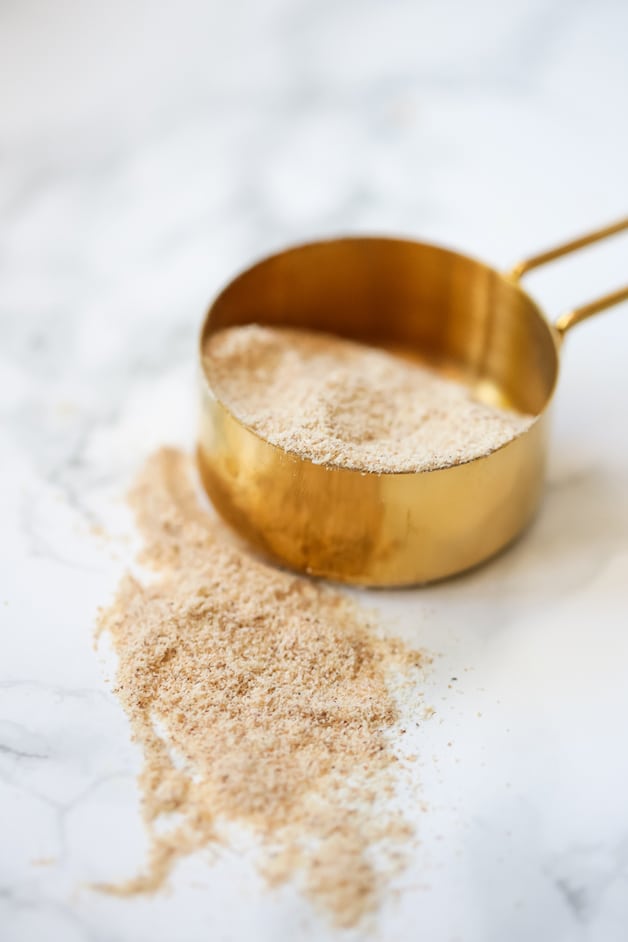The Ultimate Guide to Tigernut Flour
When I first started seeing tigernut flour used in recipes, I was straight up confused. What the heck is a tigernut? Where does it even come from? Is it a nut? Where do I buy it? My bewilderment held me back from even trying it for months. I decided to take a chance and it completely changed the way that I bake! I know that you may have a lot of questions about Tigernut Flour too, which is why I decided to share The Ultimate Guide to Tigernut Flour!

The Ultimate Guide to Tigernut Flour
First, what is a Tigernut? Is it a nut?
Tigernuts actually aren’t nuts! They look like nuts, they kind of taste like nuts, but they’re not nuts. It sounds counterintuitive, but think of water chestnuts… those aren’t nuts either, right?
Tigernuts are actually a small root vegetable that originated in Africa. They come from the Cyperus esculentus plant and have been harvested for centuries! Yes, a legit paleo ingredient.
They’re totally gluten free, nut free, grain free, and tigernut flour is wonderful alternative for those who are following protocols like a paleo diet or autoimmune protocol. If you live in a house with lots of allergies and intolerances, it’s a great option.
What can you make from tigernuts?
Similar to how creative everyone has been getting with nuts, you can get very creative with tigernuts. You can get raw or slivered tigerntus by themselves to make things like tigernut granola, tigernut butter, or tigernut milk (which is delicious), or you can buy tigernut flour to make baked goods, which is our main focus here.
Where do you buy tigernuts and tigernut flour?
Generally speaking, a lot of tigernut based products can be found in health food stores and online. Availability always varies by location, so I would double check with a store locater before you hike out to a health food store near you, but when all else fails, the internet always comes through for us.
More and more brands are popping up for tigernut based ingredients, but here are some of my favorites and where you can by them…
- Organic Gemini Tigernut Flour (Can be purchased in many health food stores and online)
- Anthony’s Goods Tigernut Flour (Can be purchased online)
- Raw Tigernuts (Can be purchased in many health food stores and online)
- Tigernut butter (Can be purchased in many health food stores and online)
- Tigernut milk/horchata (you can make this at home or buy in some stores)
What can you make with tigernut flour?
Tigernuts themselves are incredibly versatile, as is tigernut flour. It’s quickly become my favorite flour for baking sweet baked goods, and I use it often. I wouldn’t necessarily use tigernut flour is a more savory recipe like
Here are just a few of my favorite recipes that use tigernut flour…
Why use tigernut flour over coconut flour, almond flour or cassava flour?
There’s no definitive answer to this, because different baking flours are all different. No one flour is better than the other, it’s just personal preference.
However, the positives to tigernut flour are that it’s lower in hard to digest fiber like coconut flour, less starchy than cassava flour, and unlike almond flour, it’s actually nut free. As someone who works with a lot of people with gut issues, I find that they have less issues with tigernut flour than the other flours above. Of course everyone is different, but that’s generally what I see.
What does tigernut flour taste like?
Tigernut flour is similar to almond flour. It’s slightly nutty tasting, and has a nutty texture.
What’s a good substitute for tigernut flour?
Honestly, every recipe is different. It’s hard to swap grain free flours 1:1 as the amounts are so dependent on the other ingredients in the recipe. However, almond flour is your best bet.
Tips For Baking With Tigernut Flour…
- Don’t like the gritty texture? Use a sifter to give it a finer texture!
- If you’re developing new recipes for baked goods, you’ll likely have to combine tigernut flour with a starchier binder like arrowroot starch or tapioca starch. See some of the recipes above for ratio ideas.
- Keep an open mind, and enjoy!!



Hi, I love tigernut flour, for pancakes, waffles and muffins. Do you know how I could use it in a bread making machine?
I’ve honestly never tried!
Have you tried using tigernut flour in a bread machine?
I have not tried that!
I purchased the tigernut flour but forgot to say organic. Will it be alright to use?
I don’t eat everything organic, it’s mostly just a personal choice!
I’ve had trouble baking with tiger nut flour. The suggested bake time is never long enough and I find the product comes out looking raw and I have to bake it a lot longer. Why is this happening?
You may want to check your oven temp or just let the baked goods rest a bit!
I love being able to use tigernut flour, but seems like any recipe I make with them they seem to crumble quite easily, muffins, pancakes etc. I can’t have eggs so I’ve used flax, applesauce, yogurts in replacement. But no matter the recipe. How can I prevent this from happening?
I find that it’s all about the balance of the rest of the recipe. Typically I pair tigernut with arrowroot since it helps bind it!
Hi! Do you have any flour substitutes for tigernut flour besides almond flour? This would be used in an oatmeal cookie recipe. The author also suggested almond flour, but I don’t prefer or do well with almond flour!
Not really! Tigernut flour is a really unique texture/flavor so it would depend on the recipe!
What count individual raw tigernuts OR How many cups of raw tigernuts to yield 1 cup of fine flour?
If you’re grinding up raw tigernuts, I would recommend grinding them first into a flour and then measure a cup of that. You might have to do a couple batches of grinding to get a full cup of the flour.
Why do you prefer not to use it in savory applications?
It’s a bit more of a sweet flavored flour… but it can maybe work!
I have a Gf pizza crust recipe that calls for a GF flour blend as the main flour, plus 1/2 c almond flour to increase the fat. My sister in law can’t eat nuts – do you think I can substitute Tigernut flour for the almond flour?
It’s not always straight 1:1 but it can be close… it could be worth a try 🙂